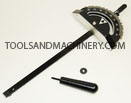WOODWORKING: How to Ensure Your Table Saw’s Miter Gauge is Square (or, Cutting Accurately)
Our table saws are one of the most integral pieces of our workshops, of our woodworking habits, and, really, of our relationships with the act and art of woodworking itself. Accordingly, it’s important that this irreplaceable and indispensable piece of equipment be constantly up to snuff. In other words, you want to ensure your table saw is always capable of delivering the best, most accurate and exact results. This, in turn, means you must be able to ensure your miter gauge is square and consistently producing accurate cuts.
 Fortunately, ascertaining and maintaining the accuracy of a table saw’s miter gauge is simpler than you might think. Depending upon the degree of inaccuracy, the process may require a moment more of your time, but, altogether, squaring a miter gauge requires little more than a scrap of wood and few measured cuts.
Fortunately, ascertaining and maintaining the accuracy of a table saw’s miter gauge is simpler than you might think. Depending upon the degree of inaccuracy, the process may require a moment more of your time, but, altogether, squaring a miter gauge requires little more than a scrap of wood and few measured cuts.
To begin testing your gauge, you must first place it as close to the front of the table saw as is physically possible. Next, you simply need to select a piece of sheet-stock or plywood (this of course can and should be scrap material) that is at least as long as the distance between the saw’s blade and the miter gauge. Of course, the longer the stock, the more evidence you’ll have to defend or deny the accuracy of the mechanism. Additionally, this test stock should be wide enough to hold easily and tightly to the miter gauge fence, or, somewhere around a width of one-foot.
HINT:
To ensure your stock stays firmly where you need it, you might utilize a thin abrasive or non-slip surface on the fence of the miter gauge. This keeps your stock in place without disrupting the cut.
In addition to the above length and width requirements, the sheet-stock must also have one perfectly straight and true edge (you might rip this edge yourself to ensure the its “truth”). This edge should be marked as the true edge to ensure accuracy later on in the process. Next, hold the true edge firmly against the fence of the miter gauge and make a thin cut along one side of the stock (removing, at most, a 1/4” strip). Flip the board ensuring the same true edge remains butted to the gauge and cut a similarly thin strip from the opposite end of the stock.
 After cutting each side, measure both ends of the board (from one newly cut edge to the other on both the top and bottom of the stock). Ideally, both ends of the sheet will be equal. This equality indicates the accuracy of the miter gauge. Accordingly, if the gauge is not square, your measurements will be different. Remember, even a minute difference of, perhaps, 1/32-in, makes a considerable difference in the overall quality of your results. It is crucial that you adjust the gauge until both measurements are equal. So, if your measurements are not equal, you will need to adjust the miter gauge, re-cut and remeasure until those length are exactly equal.
After cutting each side, measure both ends of the board (from one newly cut edge to the other on both the top and bottom of the stock). Ideally, both ends of the sheet will be equal. This equality indicates the accuracy of the miter gauge. Accordingly, if the gauge is not square, your measurements will be different. Remember, even a minute difference of, perhaps, 1/32-in, makes a considerable difference in the overall quality of your results. It is crucial that you adjust the gauge until both measurements are equal. So, if your measurements are not equal, you will need to adjust the miter gauge, re-cut and remeasure until those length are exactly equal.
HINT: If the shorter of your measurements is on the outside of the board (or, facing away from the fence), adjust the gauge counter-clockwise. If the shorter edge is on the inside of the board (or, facing the fence), adjust your gauge clockwise.













